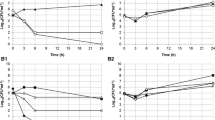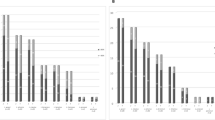Abstract
The use of probiotic microorganisms has been widely promoted in the last 20 yr (1). They have been used in the gastrointestinal tract as capsules or as fermented milks (2). The characteristics of the strains proposed as probiotics have been published (3) or patented under an elaboration process (4–6). The first step in designing a probiotic product is to isolate and characterize strains with some beneficial properties. The second step is to determine the optimal conditions to obtain the highest amount of viable microorganisms, together with the study of the best conditions to produce antagonistic substances (7).
Access this chapter
Tax calculation will be finalised at checkout
Purchases are for personal use only
Similar content being viewed by others
References
Redondo-López, V., Cook, R. L., and Sobel, J. D. (1990) Emerging role of lactobacilli in the control and maintenance of the vaginal bacterial microflora. Rev. Infect. Dis. 12, 856–872.
Reid, G. (1999) The scientific basis for probiotic strains of Lactobacillus. Appl. Environ. Microbiol. 65, 3763–3766.
Reid, G. and Bruce, A. W. (2001) Selection of Lactobacillus strains for urogenital probiotic applications. J. Infect. Dis. 183(suppl 1), S77–S80.
Chrisope, G. L. (Boulder, CO) (2000) Vaginal Lactobacillus medicant. US patent and trademark office, US Patent, GyneLogix, Inc., 093,394-6-21.
Larsen, Bryan (Huntington, WV) (1999) Vaginal pharmaceutical compositions. US patent and trademark office, US Patent, Marshall University Research Corporation, Huntington, WV, 5,958,461-7-34.
Reid, G. (London, Canada), Bruce, A. W. (Toronto, Canada) (1997) Lactobacillus and skim milk compositions and methods for preventing microbial urogenital infections. US patent and trademark office, US Patent, Research Corporation Technologies, Inc., Tucson, AZ, 5,643,830-1-1.
Mäyra-Mäkinen, A. and Bigret, M. (1998) Industrial use and production of lactic acid bacteria. In: Lactic Acid Bacteria, Microbiology and Functional Aspects (Salminen, S. and von Wright, A., eds.). Marcel Dekker, New York, pp. 73–102.
Kunin, C. M. (1994) Urinary tract infections in females. Clin. Infect. Dis. 18, 1–12.
Bollgren, I., Vaclavinkova, V., Hurvell, B., and Bergquivst, G. (1978) Periurethral aerobic microflora of pregnant and non-pregnant women. BMJ 1, 1314–1317.
Eschenbach, D., Davick, P., Williams, S., Klebanoff, S., Young-Smith, C., and Holmes, K. K. (1989) Prevalance of hydrogen-peroxide-producing Lactobacillus species in normal women and women with bacterial vaginosis. J. Clin. Microbiol. 27, 251–256.
Reid, G., McGroarty, J. A., Tomeczek, L., and Bruce, A. (1996) Identification and plasmid profiles of Lactobacillus species from the vagina of 100 healthy women. FEMS Immunol. Med. Microbiol. 15, 23–26.
Redondo-Lopez, V., Cook, R. L., Sobel, J. D. (1990) Emerging role of lactobacilli in the control and maintenance of vaginal bacterial microflora. Rev. Infect. Dis. 12, 856–872.
Hillier, S., Krohn, M. Rabe, L., Klebanoff, S., and Eschebanch, D. (1993) The normal vaginal flora, H2O2 producing lactobacilli, and bacterial vaginosis in pregnant women. Clin. Infect. Dis. 16(suppl. 4), S273–S281.
Stahl, C. and Hill, G. B. (1986) Microflora of the female genital tract. In: Infectious Diseases in the Females Patient (Galask, R. P. and Larsen, B., eds.). Springer-Verlag, New York, pp. 16–42.
Okada, H. and Hillery, A. M. (1978) Chap. 11. The Human Vagina (Hafez E. S. E. and Evans, T. N., eds.). Elsevier/North-Holland, Amsterdam, pp. 303.
Larsen, B., Markovetz A. J., and Galask R. P. (1976) Quantitative alterations in the genital microflora of female rats in relation to the estrous cycle. J. Infect. Dis. 134, 486–489.
Larsen, B., Markovetz, A. J., and Galask R. P. (1977) Role of estrogen in controlling the genital microflora of female rats. Appl. Environ. Microbiol. 34, 534–540.
McGroarty, J., Tomeczek, L., Pond, D., Reid, G., and Bruce, A. (1992) Hydrogen peroxide production by Lactobacillus species: correlation with susceptibility to the spermicidal compound nonoxynol-9. J. Infect. Dis. 165, 1142–1144.
Reid, G., Bruce, W., Cook, L., and Llano, M. (1990) Effect on urogenital flora of antibiotic therapy for urinary tract infection. Scand. Infect. Dis. 22, 43–47.
Nader de Macías, M. E., López de Bocanera, M. E., Silva de Ruiz, C., de Ruiz Holgado, A. A. P. (1992) Isolation of lactobacilli from the urogenital tract of mice-elaboration of beads for their inoculation. Microbiol. Alim. Nutr. 10, 43–47.
Silva de Ruiz, C., de Macías, M. E. N., de Bocanera, M. E. L., de Ruiz Holgado, A. P. (1993) Lactobacillus fermentum administered in suspensions and in agarose beads to mice: a comparative study. Microbiol. Alim. Nutr. 11, 391–397.
Nader de Macías, M. E., de Ruiz, C. S., de Bocanera, M. E. L., de Ruiz Holgado, A. A. P. (1996) Preventive and therapeutic effect of lactobacilli on urinary tract infections in mice. Anaerobe 2, 85–93
de Ruiz, C. S., de Bocanera, M. E., de Ruiz Holgado, A. A. P. (1996) Effect of lactobacilli and antibiotic on E. coli urinary infections in mice. Biol. Pharm. Bull. 19, 88–93.
Silva de Ruiz C., del Rosario Rey, M., and Nader-Macías, M. E. (2001) Experimental administration of estradiol on the colonization of Lactobacillus fermentum and Escherichia coli in the urogenital tract of mice. Biol. Pharm. Bull. 24, 127–134.
Takahashi, M. (1982) Papanicolaou cytological technique. In: Cytology of Cancer, Takahashi Atlas. INGAKU-SHOIN Ltd, Tokyo, Japan; Medica Panamericana, Buenos Aires, Argentina, p. 78.
Martoja, R. and Martoja-Pierson, M. (1970) Animal Histological Technique. Toray-Masson, Barcellona, chapters I–V, pp. 2–90.
Martoja, R. and Martoja-Pierson, M. (1970) Animal Histological Technique. Toray-Masson, Barcellona, chapter VI, pp. 71–116.
Author information
Authors and Affiliations
Editor information
Editors and Affiliations
Rights and permissions
Copyright information
© 2004 Humana Press Inc. Totowa, NJ
About this protocol
Cite this protocol
Silva, C., Rey, R., Nader-Macías, M.E. (2004). Effects of Estrogen Administration on the Colonization Capability of Lactobacilli and Escherichia coli in the Urinary Tracts of Mice. In: Spencer, J.F.T., Ragout de Spencer, A.L. (eds) Public Health Microbiology. Methods in Molecular Biology, vol 268. Humana Press. https://doi.org/10.1385/1-59259-766-1:387
Download citation
DOI: https://doi.org/10.1385/1-59259-766-1:387
Publisher Name: Humana Press
Print ISBN: 978-1-58829-117-2
Online ISBN: 978-1-59259-766-6
eBook Packages: Springer Protocols




